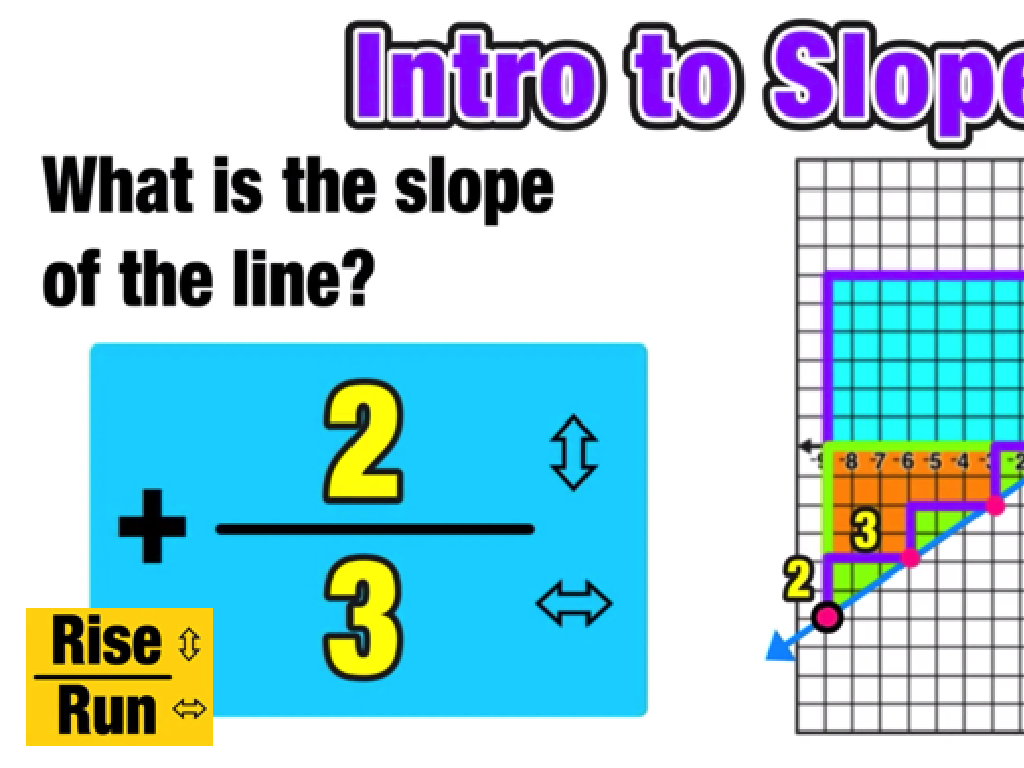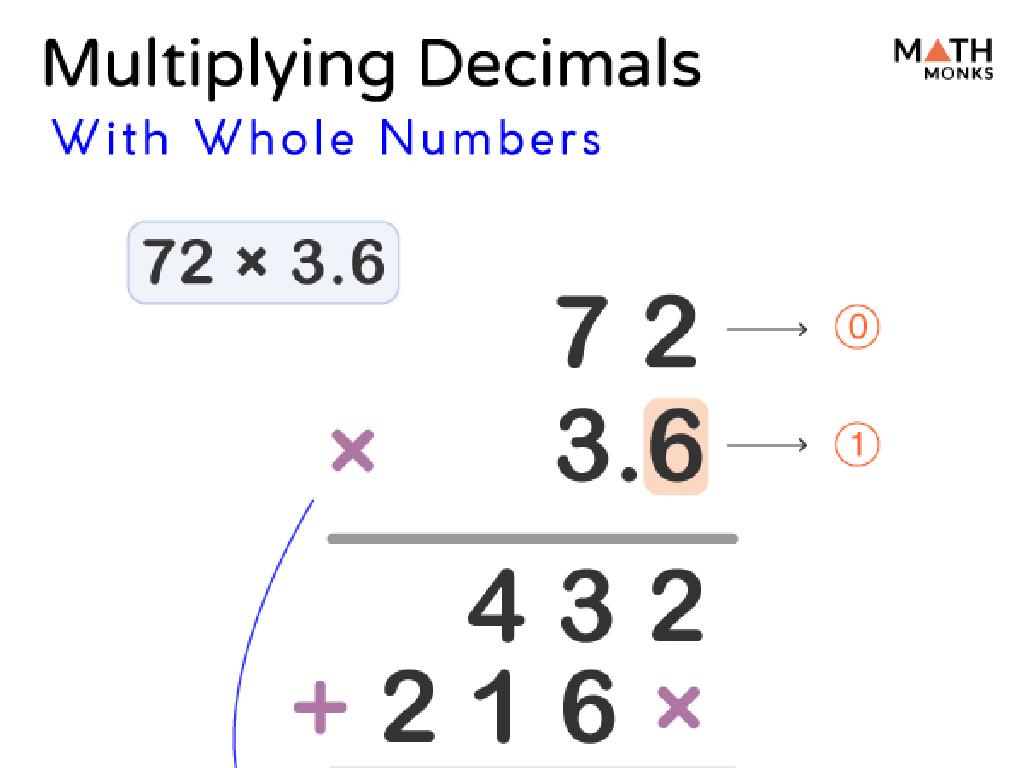Solve Two-Step Equations
Subject: Math
Grade: Eighth grade
Topic: One-Variable Equations
Please LOG IN to download the presentation. Access is available to registered users only.
View More Content
Introduction to One-Variable Equations
– Understanding basic equations
– Equations are statements of equality with unknowns
– Exploring one-variable equations
– One-variable equations have a single unknown, e.g., x + 5 = 12
– Real-life one-variable scenarios
– Budgeting allowance or measuring ingredients
– Solving two-step equations
– Combine like terms, then isolate the variable
|
This slide introduces the concept of one-variable equations, which are the foundation for understanding algebra. Start by explaining what an equation is and the significance of the equal sign. Then, move on to one-variable equations, which contain only one unknown that students need to solve for. Provide real-life examples where these equations are applicable, such as managing a budget or cooking, to make the concept relatable. Finally, demonstrate the process of solving two-step equations, emphasizing the importance of performing inverse operations to isolate the variable. Encourage students to practice with examples and to check their solutions by substituting the value back into the original equation.
Solving One-Step Equations
– Recap one-step equation definition
– An equation with a single operation to solve for x
– Explore examples of one-step equations
– For example, x – 5 = 15 or 7 = a/3
– Practice Problem: x + 3 = 10
– Find the value of x that makes the equation true
– Discuss solution steps
– Subtract 3 from both sides to isolate x
|
Begin with a brief review of what a one-step equation is, emphasizing that it contains only one operation (addition, subtraction, multiplication, or division). Provide several examples to illustrate the concept, ensuring students understand how to identify and solve these types of equations. Introduce the practice problem x + 3 = 10 and guide students through the solution process step by step. Encourage them to think about the inverse operation needed to isolate the variable x. After solving the practice problem, discuss the importance of checking the solution by substituting the value of x back into the original equation.
Solving Two-Step Equations
– Understanding Two-Step Equations
– Equations with two operations, like 2x + 3 = 11
– The Goal: Isolate the Variable
– Use inverse operations to get the variable alone
– Key Steps to Solve
– 1) Undo addition/subtraction 2) Undo multiplication/division
– Practice with Examples
– Example: Solve 2x + 3 = 11
|
Introduce two-step equations as equations that require two operations to solve. The objective is to isolate the variable on one side of the equation. Start by undoing addition or subtraction, then proceed to undo multiplication or division. Emphasize the importance of performing the same operation on both sides of the equation to maintain balance. Provide a clear example, such as solving 2x + 3 = 11, by subtracting 3 from both sides to get 2x = 8, and then dividing both sides by 2 to find x = 4. Encourage students to practice with various examples to gain confidence in solving two-step equations.
Solving Two-Step Equations: Example 1
– Start with 2x + 3 = 11
– Step 1: Subtract 3 from both sides
– After subtraction: 2x = 8
– Step 2: Divide both sides by 2
– After division: x = 4
– Find the value of x
– x equals 4 is the solution
|
This slide presents a clear example of solving a two-step equation, which is a fundamental skill in algebra. The equation 2x + 3 = 11 is a simple and straightforward example to start with. The first step involves isolating the variable term by eliminating the constant term, which is done by subtracting 3 from both sides of the equation, resulting in 2x = 8. The second step is to isolate the variable itself by dividing both sides by the coefficient of the variable, which in this case is 2, giving us x = 4. It’s crucial to ensure students understand each step’s purpose and how it brings us closer to finding the value of x. Encourage students to check their solution by plugging x back into the original equation to verify that both sides are equal.
Solving Two-Step Equations: Example 2
– Start with 5 – 3y = 16
– Add 3y to both sides
– Transform to 5 = 16 + 3y
– Divide both sides by -3
– Simplify to 5 = 16 + 3y, then 5 – 16 = 3y
– Find the value of y
– Resulting in y = -11/3 or -3.67
|
This slide provides a step-by-step example of solving a two-step equation. Begin by explaining the initial equation, 5 – 3y = 16. To isolate the variable y, add 3y to both sides, resulting in 5 = 16 + 3y. Next, subtract 16 from both sides to get -11 = 3y. Then, divide both sides by -3 to solve for y, yielding y = -11/3 or -3.67. Emphasize the importance of performing the same operation on both sides of the equation to maintain equality. Encourage students to practice with similar equations and to check their answers by substituting the value of y back into the original equation.
Practice Time: Solving Two-Step Equations
– Solve for x in 4x – 5 = 19
– Add 5 to both sides, then divide by 4
– Solve for y in 7 + 2y = 21
– Subtract 7 from both sides, then divide by 2
|
This slide is designed for class activity where students will practice solving two-step equations. The first equation is a classic example where students will need to isolate the variable x by performing two operations: first, adding 5 to both sides of the equation to cancel out the -5, and then dividing both sides by 4 to solve for x. The second equation requires students to subtract 7 from both sides to get 2y alone, and then divide by 2 to find the value of y. Encourage students to show each step of their work. As they solve these problems, remind them to perform the inverse operation to both sides of the equation to maintain balance. This exercise will help solidify their understanding of solving two-step equations and prepare them for more complex algebraic problems.
Avoiding Common Mistakes in Two-Step Equations
– Perform operations on both sides
– Always mirror operations on each side to maintain balance.
– Simplify the equation fully
– Ensure all like terms are combined and the equation is in simplest form.
– Review and correct mistakes
– Use example problems to identify and fix common errors.
|
This slide aims to highlight frequent errors students make when solving two-step equations. Emphasize the importance of maintaining balance by performing the same mathematical operation on both sides of the equation. Stress the need for simplification, which includes combining like terms and reducing fractions if necessary. Provide practice problems that contain deliberate mistakes for students to find and correct, reinforcing their understanding of the correct methods. This exercise will help students recognize and avoid these common pitfalls in the future.
Class Activity: Equation Relay Race
– Split into teams for the race
– Each member solves a step
– Complete the equation together
– First team to finish wins a point
|
This interactive class activity is designed to encourage collaboration and reinforce the concept of solving two-step equations. Divide the class into small teams, ensuring that each team has an equal number of members. Provide each team with a set of two-step equations. Each member is responsible for solving one step of the equation before passing it to the next teammate. This relay continues until the equation is solved. The first team to solve their equation correctly earns a point. To ensure a smooth activity, prepare multiple sets of equations with varying difficulty levels. Monitor the teams to provide guidance and verify the accuracy of their solutions. This activity not only helps students practice their problem-solving skills but also promotes teamwork and healthy competition.
Homework and Further Practice: Two-Step Equations
– Complete the worksheet provided
– Create your own two-step equations
– Use different numbers and operations
– Study for the upcoming quiz
– Focus on one-variable equations
– Practice makes perfect!
|
This slide is aimed at reinforcing students’ understanding of solving two-step equations by providing them with a structured homework assignment. The worksheet will contain a variety of problems to solve, ensuring that students practice different types of two-step equations. Encouraging students to create their own equations will help them understand the structure and logic behind them. Remind students that the quiz will cover all aspects of one-variable equations, so they should review their notes and practice additional problems. Emphasize the importance of consistent practice to build confidence and proficiency in solving equations.
Conclusion: Mastering Two-Step Equations
– Recap solving two-step equations
– Review the steps: isolate the variable, balance the equation
– Practice leads to proficiency
– Regular practice solidifies understanding
– Consistency is key in learning
– Consistent study habits improve skills over time
– Engage in Q&A session
– Clarify doubts and reinforce learning
|
As we wrap up today’s lesson on two-step equations, it’s crucial to revisit the steps we’ve learned to isolate the variable and balance the equation. Emphasize the importance of regular practice, as it is through repetition that students will solidify their understanding of the concepts. Encourage them to maintain consistent study habits, which will help them improve their math skills over time. Conclude the lesson with a Q&A session, allowing students to ask questions and clarify any doubts they may have. This interactive session not only reinforces what they’ve learned but also helps identify areas that may need more focus or explanation.






